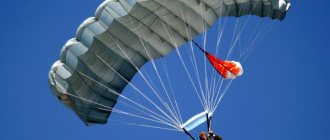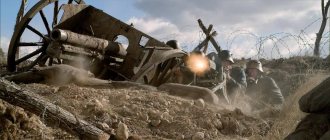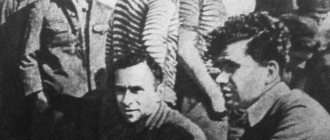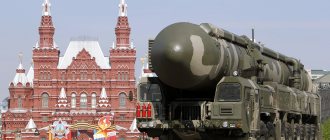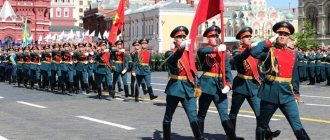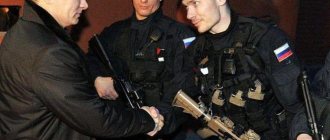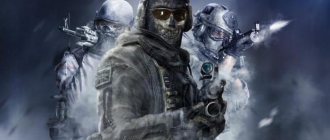Airborne troops (Airborne Forces) are an independent branch of the Armed Forces of the Russian Federation, designed for operational landing and combat operations behind enemy lines. The Airborne Forces are considered the reserve of the Supreme Commander-in-Chief and are directly subordinate to the Airborne Forces commander.
Let's take a closer look at the Russian airborne troops, their history of creation and development, main tasks, structure and composition, weapons and equipment, and also find out when the professional holiday is celebrated and some interesting facts.
History of creation
Unlike most branches of the military, the Airborne Forces were created in the Soviet Union. In the early 30s, the first aviation motorized landing detachment was formed in the Leningrad Military District.
Formation of troops in the USSR
The first landing of troops took place in Turkestan in 1929 during the capture of the city of Garm. Then a detachment of Red Army soldiers was parachuted into territory controlled by the Basmachi and destroyed the enemy.
Created in 1931, the aviation motorized landing force had already grown to 29 airborne battalions by 1933. They were armed not only with small arms in the form of machine guns and sniper rifles, but also light tanks, motorcycles, 76 mm guns and armored personnel carriers.
In 1935, the first mass landing exercises took place in the Kiev Military District. 1188 Red Army soldiers captured the “enemy” airfield within 2 hours.
In 1936, 3,000 paratroopers and 8,000 people landed on the territory of the Belarusian Military District. At the same time, they landed together with light military equipment. The exercises turned out to be so large-scale and effective that they were reflected in the assessment of foreign observers.
During the Great Patriotic War, the widespread use of airborne troops led to the formation of 10 regiments and 5 brigades by 1943. In 1942, the first Airborne Forces School was created in the city of Kuibyshev.
For heroism and courage during the war, 296 paratroopers received the highest award - Hero of the Soviet Union, and thousands of paratroopers were awarded orders and medals.
Since July 10, 1946, the Airborne Forces have been part of the country's Ground Forces, reporting directly to the USSR Minister of Defense, and since 1953 they have become his main reserve.
In the 50s - 80s of the twentieth century, airborne troops participated in many local conflicts in Europe and on other continents. Combat operations in Prague and Bratislava, Czechoslovakia, Angola, and Afghanistan were carried out by airborne forces. Moreover, this is not a complete list of countries and cities in which Soviet paratroopers were able to defuse political passions and stop fratricidal wars.
Airborne troops today
The Airborne Forces of the Russian Federation are the legacy of the Union of Soviet Socialist Republics, divided in 1992 between the union republics. The troops became the reserve of the Supreme Commander-in-Chief, the main tasks remained unchanged.
Conscript service in the Airborne Forces is prestigious and promising, distinguished by a very high level of combat training.
Tasks that airborne special forces must solve
The main task of special forces is to completely demoralize the enemy. Suddenly appearing behind enemy lines, experienced fighters who have excellent training are capable of causing significant damage to the enemy in a matter of minutes. Seeing how a small detachment can easily cope with many times superior forces, the enemy loses faith in victory and easily turns into panic. The task of the regular troops at this moment is to support the special forces and occupy captured positions.
In addition, airborne special forces are capable of carrying out sabotage activities behind enemy lines, organizing resistance units and “luring” civilians to their side. For this purpose, airborne special forces units not only undergo special psychological training, but also have mobile television stations capable of providing broadcasting within a radius of about 10 kilometers.
In peacetime, there is also a lot of work for airborne special forces soldiers. In addition, Russian special forces annually take part in competitions that take place among special forces of the leading countries of the world. Russian special forces constantly take first place, beating both the famous Green Berets and British special forces.
The training of airborne special forces is still at its best, but every year it becomes more and more difficult to recruit recruits. There are plenty of people willing, but it is quite difficult to choose the worthy ones among them. If previously each applicant had a sports rank (often even in several sports), now such conscripts are quite rare.
Main goals
The Command of the Airborne Forces (Airborne Forces) is intended to organize, plan and implement measures for the construction (development) of the Airborne Forces, the training and use of formations and military units of the Airborne Forces.
The Airborne Forces Command is the central body of military command and is subordinate to the Chief of the General Staff of the Armed Forces of the Russian Federation.
The main tasks of the Airborne Forces Command:
- organization of the use of formations and military units of the Airborne Forces;
- organizing and conducting activities for the construction of airborne forces;
- organizing the maintenance of combat and mobilization readiness of formations and military units of the Airborne Forces;
- organizing and conducting training activities for the Airborne Forces Command, formations and military units of the Airborne Forces to carry out assigned tasks;
- participation in the planning and implementation of logistical, moral and psychological support for airborne formations and military units;
- organization and management of the daily activities of formations and military units of the Airborne Forces.
Structure and composition of the airborne troops of the Russian Federation
Currently, the Russian Airborne Forces consist of command structures, combat units and units, as well as various institutions that provide them.
Structurally, the Airborne Forces have three main components:
- Airborne. It includes all airborne units.
- Air assault. Consists of air assault units.
- Mountain. It includes air assault units designed to operate in mountainous areas.
Currently, the Russian Airborne Forces include four divisions, as well as individual brigades and regiments.
Airborne troops, composition:
- 76th Guards Air Assault Division, stationed in Pskov.
- 98th Guards Airborne Division, located in Ivanovo.
- 7th Guards Air Assault (Mountain) Division, stationed in Novorossiysk.
- 106th Guards Airborne Division - Tula.
Airborne regiments and brigades:
- 11th Separate Guards Airborne Brigade, headquartered in the city of Ulan-Ude.
- 45th separate guards special purpose brigade (Moscow).
- 56th Separate Guards Air Assault Brigade. Place of deployment - the city of Kamyshin.
- 31st Separate Guards Air Assault Brigade. Located in Ulyanovsk.
- 83rd Separate Guards Airborne Brigade. Location: Ussuriysk.
- 38th Separate Guards Airborne Communications Regiment. Located in the Moscow region, in the village of Medvezhye Ozera.
In 2013, the creation of the 345th Air Assault Brigade in Voronezh was officially announced, but then the formation of the unit was postponed to a later date (2017 or 2020). There is information that in 2022, an air assault battalion will be deployed on the territory of the Crimean Peninsula, and in the future, on its basis, a regiment of the 7th Air Assault Division, which is currently deployed in Novorossiysk, will be formed.
In addition to combat units, the Russian Airborne Forces also include educational institutions that train personnel for the Airborne Forces. The main and most famous of them is the Ryazan Higher Airborne Command School, which also trains officers for the Russian Airborne Forces. The structure of this type of troops also includes two Suvorov schools (in Tula and Ulyanovsk), the Omsk Cadet Corps and the 242nd training center located in Omsk.
How to get into the airborne special forces
Those applicants who want to join the airborne special forces must have already served military service and have high health indicators, which are required for future special forces. After passing the medical examination, applicants are subjected to a variety of tests that are designed to determine mental health and readiness for service in special forces.
The most calm and balanced applicants are taken as snipers or sappers, the rest are assigned to military professions according to their temperament and psychological stability. Those applicants who do not pass the tests are offered service in other parts of the Russian army.
After selection, training begins, which no more than 40 percent of applicants pass. If after the exercise there are too few people left, the empty seats are filled by the best airborne soldiers who have proven themselves to be excellent during their military service. Such strict selection leads to the fact that after a year of training, fighters are already experts in the use of various types of weapons and special devices. The best airborne special forces fighters are true universal soldiers, although almost each of them is better at some military profession than others.
In the short time that the Airborne Special Forces have existed, its officers and soldiers have managed to take part in all the military conflicts in which Russia was drawn. Until now, airborne special forces fighters are the most elite warriors of the army of the Russian Federation. Numerous medals and orders awarded to soldiers and officers of the Airborne Special Forces serve as clear proof of this.
Armament and equipment of the Russian Airborne Forces
The airborne troops of the Russian Federation use both combined arms equipment and models that were created specifically for this type of troops. Most types of weapons and military equipment of the Airborne Forces were developed and manufactured during the Soviet period, but there are also more modern models created in modern times.
The most popular types of airborne armored vehicles are currently the BMD-1 (about 100 units) and BMD-2M (about 1 thousand units) airborne combat vehicles. Both of these vehicles were produced in the Soviet Union (BMD-1 in 1968, BMD-2 in 1985). They can be used for landing both by landing and by parachute. These are reliable vehicles that have been tested in many armed conflicts, but they are clearly outdated, both morally and physically. Even representatives of the top leadership of the Russian army openly declare this.
More modern is the BMD-3, which began operation in 1990. Currently, 10 units of this combat vehicle are in service. Serial production has been discontinued. The BMD-3 should replace the BMD-4, which was put into service in 2004. However, its production is slow; today there are 30 BMP-4 units and 12 BMP-4M units in service.
Airborne units also have a small number of armored personnel carriers BTR-82A and BTR-82AM (12 units), as well as the Soviet BTR-80. The most numerous armored personnel carrier currently used by the Russian Airborne Forces is the tracked BTR-D (more than 700 units). It was put into service in 1974 and is very outdated. It should be replaced by the BTR-MDM “Rakushka”, but so far its production is moving very slowly: today there are from 12 to 30 (according to various sources) “Rakushka” in combat units.
The anti-tank weapons of the Airborne Forces are represented by the 2S25 Sprut-SD self-propelled anti-tank gun (36 units), BTR-RD Robot self-propelled anti-tank systems (more than 100 units) and a wide range of different ATGMs: Metis, Fagot, Konkurs and "Cornet".
The Russian Airborne Forces also have self-propelled and towed artillery: the Nona self-propelled gun (250 units and several hundred more units in storage), the D-30 howitzer (150 units), and the Nona-M1 mortars (50 units) and "Tray" (150 units).
Airborne air defense systems consist of man-portable missile systems (various modifications of Igla and Verba), as well as short-range air defense systems Strela. Special attention should be paid to the newest Russian MANPADS “Verba”, which was only recently put into service and is now being put into trial operation in only a few units of the Russian Armed Forces, including the 98th Airborne Division.
The Airborne Forces also operate self-propelled anti-aircraft artillery mounts BTR-ZD "Skrezhet" (150 units) of Soviet production and towed anti-aircraft artillery mounts ZU-23-2.
In recent years, the Airborne Forces have begun to receive new models of automotive equipment, of which the Tiger armored car, the A-1 Snowmobile all-terrain vehicle and the KAMAZ-43501 truck should be noted.
The airborne troops are sufficiently equipped with communication, control and electronic warfare systems. Among them, modern Russian developments should be noted: electronic warfare systems "Leer-2" and "Leer-3", "Infauna", the control system for air defense complexes "Barnaul", automated troop control systems "Andromeda-D" and "Polet-K".
The Airborne Forces are armed with a wide range of small arms, including both Soviet models and newer Russian developments. The latter include the Yarygin pistol, PMM and the PSS silent pistol. The main personal weapon of the fighters remains the Soviet AK-74 assault rifle, but deliveries to the troops of the more advanced AK-74M have already begun. To carry out sabotage missions, paratroopers can use the silent “Val” assault rifle.
The Airborne Forces are armed with the Pecheneg (Russia) and NSV (USSR) machine guns, as well as the Kord heavy machine gun (Russia).
Among the sniper systems, it is worth noting the SV-98 (Russia) and Vintorez (USSR), as well as the Austrian sniper rifle Steyr SSG 04, which was purchased for the needs of special forces of the Airborne Forces. The paratroopers are armed with the AGS-17 “Flame” and AGS-30 automatic grenade launchers, as well as the SPG-9 “Spear” mounted grenade launcher. In addition, a number of hand-held anti-tank grenade launchers of both Soviet and Russian production are used.
To conduct aerial reconnaissance and adjust artillery fire, the Airborne Forces use Russian-made Orlan-10 unmanned aerial vehicles. The exact number of Orlans in service with the Airborne Forces is unknown.
The Russian Airborne Forces use a large number of different parachute systems of Soviet and Russian production. With their help, both personnel and military equipment are landed.
“Where hell ends, airborne forces begin.” An outside view of the airborne troops
In the fog of stars the plane departs Back to the assigned base, And our soldier’s duty calls us here - The landing force was sent to the west by order.
And somewhere between the parachute lines, Bratislava is burning with lights below, And the guys from Moscow and Volgograd slowly sit down on the sand.
Control tower at Ruzyne International Airport, Prague. An ordinary night shift turns into a nightmare: an armada of aircraft is approaching on the radar screens. Who are they? What's happening? Commands in Czech are growled over the radio: “Stop releasing and receiving aircraft, immediately vacate the runway.”
Behind the dispatchers, the door crunches and falls over, and armed people without insignia burst into the room. The Czechs finally understand what is happening - someone manages to break the radio equipment. The control tower is out of action, but GRU special forces are already in full swing on the airfield, having landed a couple of hours before the main forces disembarked on board a “Trojan horse” - a civilian aircraft that requested an emergency landing.
A small scuffle breaks out at the airport fire brigade building - firefighters, warned from the control center, are trying to block the runway with cars and special equipment. But when they come face to face with armed Soviet special forces, they hastily retreat. The airport terminal building is blocked, all exits to the field and approaches to the runway are blocked. We made it!
And in the sky above Prague the landing lights of the An-12 are already swinging. The first pot-bellied transporter comes in to land, unloads, in a matter of minutes - and the plane, roaring with four engines, leaves for reinforcements. Piles of unused parachutes remain along the edges of the airfield. In total, over the next 24 hours, 450 aircraft carrying units of the 7th Guards landed at Ruzyne airport. airborne division...
If we had been thrown out at night, then half of the division... Do you know how many people were at the airfields, how many planes, how many people I would have killed? - General Lev Gorelov, at that time commander of the 7th Guards. Airborne Division
The word “parachute” practically does not appear in the Airborne Forces combat manual. And in each paragraph of the charter devoted to landing, clarifications are always prudently followed: “dropping troops (landing)” or “landing site (airfield).” The charter was written by smart people who knew very well military history and the practice of using airborne assault forces in various military conflicts.
Parachute landing of armored vehicles. Fantastic spectacle
The largest operation in the history of the Russian Airborne Forces was the Vyazma airborne operation, carried out by four airborne brigades and the 250th Rifle Regiment of the Red Army in January-February 1942. And many tragic and instructive moments were associated with this event.
The first group of paratroopers was landed behind German troops south of Vyazma on January 18 - 22, 1942. It is noteworthy that the 250th Infantry Regiment landed (attention!) by landing method. Thanks to the successful actions of the paratroopers, a few days later the 1st Guards Cavalry Corps of the Red Army broke into their location. The possibility of encircling part of the German forces of Army Group Center emerged.
To strengthen the Soviet group, a second group of paratroopers was urgently landed behind enemy lines. By February 1, 2,497 people and 34 tons of cargo were parachuted into the indicated area. The result was discouraging - the cargo was lost, and only 1,300 paratroopers reached the collection site.
No less alarming results were obtained during the Dnieper airborne operation - strong anti-aircraft fire forced the planes to rise above the clouds, as a result, dropped from a two-kilometer altitude, 4,500 paratroopers were scattered over an area of tens of square kilometers. Based on the results of the operation, the following directive was issued:
The release of a mass landing at night indicates the illiteracy of the organizers of this matter, because, as experience shows, the release of a massive night landing, even on one’s own territory, is associated with great dangers. I order the remaining one and a half airborne brigades to be removed from the subordination of the Voronezh Front and considered as a reserve of the Headquarters. I.STALIN
It is no coincidence that most of the airborne units of the Red Army were reorganized into rifle units during the war.
Mass airborne assaults in the Western European theater of operations had similar consequences. In May 1941, 16 thousand German paratroopers, showing exceptional heroism, were able to capture the island of Crete (Operation Mercury), but suffered such heavy losses that the Wehrmacht air force dropped out of the game forever. And the German command had to give up plans to seize the Suez Canal with the help of paratroopers.
Body of a killed German paratrooper, Operation Mercury
In the summer of 1943, American paratroopers found themselves in equally difficult conditions: during the landing in Sicily, due to strong winds, they found themselves 80 kilometers from their intended target. The British were even less fortunate that day - a quarter of the British paratroopers drowned at sea.
Well, World War II ended a long time ago - since then, landing systems, communication and control systems have radically changed for the better. Let's look at a couple of more recent examples:
Here, for example, is the Israeli elite parachute brigade “Tsanhanim”. This unit has one successful parachute landing: the capture of the strategically important Mitla Pass (1956). However, there are a number of contradictory points here: firstly, the landing was targeted - only a couple of hundred paratroopers. Secondly, the landing took place in a desert area, initially without any enemy opposition.
In subsequent years, the Tsanhaim parachute brigade was never used for its intended purpose: the soldiers deftly jumped with a parachute during exercises, but in real combat conditions (the Six-Day War or the Yom Kippur War) they preferred to move on the ground under the cover of heavy armored vehicles, or carried out targeted sabotage operations using helicopters.
Airborne troops are a highly mobile branch of the Ground Forces and are designed to perform tasks behind enemy lines as airborne assault forces - Airborne Forces Combat Manual, paragraph 1
Soviet paratroopers repeatedly took part in combat operations outside the USSR, participated in suppressing rebellions in Hungary and Czechoslovakia, fought in Afghanistan and were the recognized elite of the Armed Forces. However, the actual combat use of the Airborne Forces was very different from the romantic image of a paratrooper descending from the sky on parachute lines, as was widely represented in popular culture.
Suppression of the uprising in Hungary (November 1956): - soldiers of the 108th Guards Parachute Regiment were delivered to the Hungarian airfields of Tekel and Veszprém, and immediately captured strategically important objects. Now, having captured the air gates, it was possible to easily receive help and reinforcements and develop an offensive deep into enemy territory. - The 80th Guards Parachute Regiment arrived at the border with Hungary by rail (Beregovo station), from there it made a 400-km march to Budapest in a marching column;
Suppression of the uprising in Czechoslovakia (1968): During Operation Danube, Soviet troops, supported by Bulgarian, Polish, Hungarian and German units, established control over Czechoslovakia within 36 hours, carrying out a quick and bloodless occupation of the country. It was the events of August 21, 1968, associated with the brilliant capture of the Ruzyne International Airport, that became the prologue to this article. In addition to the capital's airport, the Soviet landing force captured the airfields of Turany and Namešti, turning them into impregnable fortified points, where more and more forces arrived from the USSR in an endless stream.
Introduction of troops into Afghanistan (1979): The Soviet landing force captured all the most important airfields of this Central Asian country in a matter of hours: Kabul, Bagram and Shindad (Kandahar was captured later). Within a few days, large forces of the Limited Contingent of Soviet Forces arrived there, and the airfields themselves turned into the most important transport portals for the delivery of weapons, equipment, fuel, food and equipment for the 40th Army.
The defense of the airfield is organized by separate company (platoon) strongholds with anti-tank weapons and air defense systems located in them in the directions of probable enemy advance. Removing the front edge of strong points should prevent aircraft on the runway from being hit by direct fire from enemy tanks and guns. The gaps between the strong points are covered with mine-explosive barriers. Advancement routes and reserve deployment lines are being prepared. Some units are allocated for ambush operations along enemy approach routes. — Combat regulations of the Airborne Forces, paragraph 206
Damn it! This is even stated in the Charter.
Rather than crawling onto a seashore covered with thorns or jumping from sky-high heights into the unknown, it is much easier and more effective to land at the capital’s airport on enemy territory, dig in, and transfer a division of “Pskov thugs” there in one night. Prompt delivery of heavy armored vehicles and other bulky equipment becomes possible. Paratroopers receive timely assistance and reinforcements, the evacuation of the wounded and prisoners is simplified, and convenient transport routes connecting the capital's airport with the center of the country make this facility truly invaluable in any local war.
The only risk is that the enemy might guess the plans and at the last moment block the runway with bulldozers. But, as practice shows, with a proper approach to ensuring secrecy, no serious problems arise. Finally, for insurance, you can use an advance detachment disguised as a “peaceful Soviet tractor”, which will restore order on the airfield a few minutes before the arrival of the main forces (this opens up wide scope for improvisation: an “emergency” landing, a group of “athletes” with black bags "Adibas", etc.)
Preparing a captured airfield (landing site) for receiving troops and materiel consists of clearing the runway and taxiways for landing aircraft (helicopters), unloading equipment and cargo from them, and equipping access roads for vehicles. — Airborne Forces combat regulations, paragraph 258
Actually, there is nothing new here - the ingenious tactic of capturing the airport appeared half a century ago. Budapest, Prague and Bagram are clear evidence of this scheme. According to the same scenario, the Americans landed at Mogadishu airport (civil war in Somalia, 1993). The same scenario was followed by peacekeeping forces in Bosnia (taking control of the Tuzla airport, early 90s), which was subsequently turned into the main support base of the Blue Helmets.
Russian paratroopers unload equipment. Tuzla Airport, Bosnia
The main objective of the “Throw on Pristina” - the famous raid of Russian paratroopers in June 1999 was... who would have thought! ... the capture of the Slatina airport, where reinforcements were expected to arrive - up to two airborne regiments. The operation itself was carried out brilliantly (its inglorious ending is no longer relevant to the topic of this article, since it has a clear political rather than military overtones). Of course, the technique of “capturing the capital’s airport” is only suitable for local wars with an obviously weak and unprepared enemy.
It was already unrealistic to repeat such a trick in Iraq - the wars in the Persian Gulf were carried out in the spirit of old traditions: aircraft bomb, tank and motorized columns rush forward, and, if necessary, targeted landing groups are landed behind enemy lines: special forces, saboteurs, air spotters. However, there was never any talk of any mass drops of paratroopers. First of all, there was no need for this.
Secondly, a mass parachute landing in our time is an unjustifiably risky and senseless event: just remember the quote from General Lev Gorelov, who honestly admitted that in the event of a parachute landing, half of his division could have died. But the Czechs in 1968 had neither the S-300, nor the Patriot air defense system, nor the portable Stingers...
Pskov paratroopers preparing for landing, 2005
The use of parachute landings in World War III seems an even more dubious idea. In conditions when even supersonic fighters are at mortal risk in the fire zone of modern anti-aircraft missile systems, one can hope that the huge transport Il-76 will be able to fly and land troops near Washington... Popular rumor attributes to Reagan the phrase: “I wouldn’t be surprised if on the second day of the war I’ll see guys in vests and blue berets on the threshold of the White House.” I don’t know if the US President said such words, but he is guaranteed to receive thermonuclear ammunition half an hour after the start of the war.
Based on historical experience, paratroopers performed well as part of air assault brigades - in the late 60s, the rapid development of helicopter technology made it possible to develop the concept of using landing forces in the enemy’s close rear areas. Targeted helicopter landings played a significant role in the Afghan war.
The paratrooper first runs as much as he can, and then runs as long as necessary - Army humor
Over the past 30 years, a unique image of the paratrooper has formed in Russian society: for some unclear reasons, the paratroopers do not “hang on slings,” but sit on the armor of tanks and infantry fighting vehicles in all hot spots.
That's right - the Airborne Forces, the beauty and pride of the Armed Forces, being one of the most trained and combat-ready branches of the military, are regularly involved in carrying out tasks in local conflicts. In this case, the landing force is used as motorized infantry, together with units of motorized rifle, special forces, riot police and even marines! (It’s no secret that Russian marines took part in the assault on Grozny).
5th company of the 350th Guards. airborne regiment, Afghanistan
This raises a reasonable philistine question: if over the past 70 years, the Airborne Forces have never, under any circumstances, been used for their intended purpose (namely, a massive landing of paratroopers), then why are there conversations about the need for specific systems suitable for landing under a parachute canopy: combat BMD-4M airborne assault vehicle or 2S25 Sprut anti-tank self-propelled gun?
If landing forces are always used as elite motorized infantry in local wars, then isn’t it better to arm the guys with conventional tanks, heavy self-propelled guns and infantry fighting vehicles? Operating on the front line without heavy armored vehicles is a betrayal towards the soldiers.
Look at the US Marine Corps - the American Marines have forgotten the smell of the sea. The Marine Corps has become an expeditionary force - a kind of "special forces" trained for operations outside the United States, with its own tanks, helicopters and aircraft. The Marines' main armored vehicle is the 65-ton Abrams tank, a pile of negatively buoyant iron.
BMD-4M. A beautiful car, but one hit from a DShK bullet will tear the track
It is worth noting that domestic airborne forces also serve as quick reaction forces, capable of arriving anywhere in the world and entering battle immediately upon arrival. It is clear that in this case the paratroopers need a special vehicle, but why do they need the aluminum BMP-4M, at the price of three T-90 tanks? Which, ultimately, is hit by the most primitive means: DShK and RPG-7 shots.
Of course, there is no need to go to the point of absurdity - in 1968, due to a shortage of vehicles, paratroopers stole all cars from the parking lot of Ruzyne Airport. And they did it right:
...explaining to personnel the need for rational use of ammunition and other material resources, skillful use of weapons and military equipment captured from the enemy; — Airborne Forces combat regulations, paragraph 57
I would like to know the opinion of the airborne forces, what is it about their conventional armored personnel carriers and infantry fighting vehicles that do not satisfy them, compared to the “super machine” BMD-4M?
Dress
For everyday wear, the standard military uniform is used, with the exception of the blue beret, recognizable throughout the world. Only Russian paratroopers wear a blue beret. The paratroopers of other countries take maroon, crimson or red. The buttonholes, shoulder straps, band on the cap and piping on the uniform trousers are also blue.
Another distinctive feature of the paratrooper uniform is the vest. Unlike the naval undershirt, the paratrooper’s “vest” has light blue stripes. Airborne Forces Commander V.F. Margelov often checked his officers for wearing this attribute of the uniform. And if under his uniform the officer had standard underwear instead of a vest, he was shown the door.
During field training, a soldier's headdress is a cap, hat or Panama hat.
The field uniform has changed many times over the decades. The reason for this was the constant work to improve and modernize clothing based on the results of combat and training operations. For example, after the events in Angola and a number of other African countries, the famous “mabuta” was developed - a field uniform with patch pockets on a soldier’s trousers and jacket. And among the paratroopers, the uniform received its name from the name of General Mabuta, who was assisted in that local conflict on the territory of an African state.
The paratroopers are the first to receive all the new military uniforms. After all, they, like no one else, can check its convenience, durability, quality, etc. Another example of such a form, born of a military conflict, is the “slide,” which became widely used after the war in the Caucasus.
Interesting Facts
The AN-12 aircraft, intended for landing people and military equipment, was designed based on the dimensions and tonnage of the BMD. According to technical conditions, the car had to easily fit into the cargo hatch. That is, a huge transport aircraft was adjusted in size to the landing equipment.
The legendary commander of the Airborne Forces, Vasily Filippovich Margelov, was famous for his fanatical devotion to his troops and, accordingly, enjoyed the respect and love of his subordinates. That is why the abbreviation “VDV” sometimes stands for Uncle Vasya’s Troops. And the first landing of a BMD with a crew on board in history was carried out by Lieutenant Colonel A.G. Zuev and the son of the commander, Lieutenant A.V. Margelov.
If, upon admission to the Ryazan Higher Airborne Command School, the applicant does not have enough points for admission, he goes to “partisan”. This is a kind of voluntary test, which consists in the fact that applicants settle in the forests surrounding the school and live there for several weeks, or even months. According to tradition, those applicants who were able to survive in the forest for a certain period of time get a second chance to enter the school. This is how the young man confirms the fortitude necessary to serve in the Airborne Forces.
